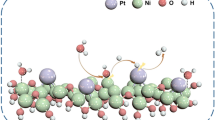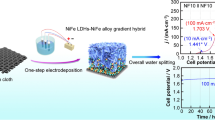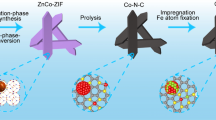Abstract
Nickel selenide electrocatalysts for hydrogen evolution reaction (HER) with a high efficiency and a low-cost have a significant potential in the development of water splitting. However, the inferiority of the high overpotential and poor stability restricts their practical applications. Herein, a composite nanostructure consists of ultrasmall NiSe2 nanocrystals embedded on graphene by microwave reaction is reported. The prepared NiSe2/reduced graphite oxide (rGO) electrocatalyst exhibited a high HER activity with an overpotential of 158 mV at a current density of 10 mA/cm2 and a corresponding moderate Tafel slope of 56 mV/dec in alkaline electrolyte. In addition, a high retention of electrochemical properties (approximately 100%) was demonstrated with an unchangeable microstructure after 100 h of continuous operation.
Similar content being viewed by others
References
Fang Z, Peng L, Qian Y, et al. Dual tuning of Ni-Co-A (A = P, Se, O) nanosheets by anion substitution and holey engineering for efficient hydrogen evolution. Journal of the American Chemical Society, 2018, 140(15): 5241–5247
Sun Y, Xu K, Wei Z, et al. Strong electronic interaction in dualcation-incorporated NiSe2 nanosheets with lattice distortion for highly efficient overall water splitting. Advanced Materials, 2018, 30(35): 1802121
Liu B, Wang Y, Peng H, et al. Iron vacancies induced bifunctionality in ultrathin feroxyhyte nanosheets for overall water splitting. Advanced Materials, 2018, 30(36): 1803144
Hua W, Sun H, Xu F, et al. A review and perspective on molybdenum-based electrocatalysts for hydrogen evolution reaction. Rare Metals, 2020, 39(4): 335–351
Gao R, Zou J. Towards designing efficient catalyst for hydrogen oxidation reaction. Rare Metals, 2020, 39(10): 1107–1109
Peng X, Yan Y, ** X, et al. Recent advance and prospectives of electrocatalysts based on transition metal selenides for efficient water splitting. Nano Energy, 2020, 78(25): 105234
Chen L, Jang H, Kim M, et al. Fe, Al-co-doped NiSe2 nanoparticles on reduced graphene oxide as an efficient bifunctional electrocatalyst for overall water splitting. Nanoscale, 2020, 12(25): 13680–13687
Jiang H, Wang Z, Yang Q, et al. Ultrathin Ti3C2Tx (MXene) nanosheet-wrapped NiSe2 octahedral crystal for enhanced supercapacitor performance and synergetic electrocatalytic water splitting. Nano-Micro Letters, 2019, 11(1): 31
Fang X, Ren L, Li F, et al. Modulating electronic structure of CoSe2 by Ni do** for efficient electrocatalyst for hydrogen evolution reaction. Rare Metals, 2022, 41: 901–910
Ming F, Liang H, Shi H, et al. MOF-derived Co-doped nickel selenide/C electrocatalysts supported on Ni foam for overall water splitting. Journal of Materials Chemistry. A, Materials for Energy and Sustainability, 2016, 4(39): 15148–15155
Wang F, Li Y, Shifa T, et al. Selenium-enriched nickel selenide nanosheets as a robust electrocatalyst for hydrogen generation. Angewandte Chemie International Edition, 2016, 55(24): 6919–6924
Swesi A, Masud J, Nath M. Nickel selenide as a high-efficiency catalyst for oxygen evolution reaction. Energy Environmental Science, 2016, 9(5): 1771–1782
Kirubasankar B, Murugadoss V, Lin J, et al. In situ grown nickel selenide on graphene nanohybrid electrodes for high energy density asymmetric supercapacitors. Nanoscale, 2018, 10(43): 20414–20425
Fang G, Wang Q, Zhou J, et al. Metal organic framework-templated synthesis of bimetallic selenides with rich phase boundaries for sodium-ion storage and oxygen evolution reaction. ACS Nano, 2019, 13(5): 5635–5645
Yan L, Jiang H, **ng Y, et al. Nickel metal-organic framework implanted on graphene and incubated to be ultrasmall nickel phosphide nanocrystals acts as a highly efficient water splitting electrocatalyst. Journal of Materials Chemistry A, Materials for Energy and Sustainability, 2018, 6(4): 1682–1691
Wang S, He P, Jia L, et al. Nanocoral-like composite of nickel selenide nanoparticles anchored on two-dimensional multi-layered graphitic carbon nitride: a highly efficient electrocatalyst for oxygen evolution reaction. Applied Catalysis B: Environmental, 2019, 243: 463–469
Fu G, Yan X, Chen Y, et al. Boosting bifunctional oxygen electrocatalysis with 3D graphene aerogel-supported Ni/MnO particles. Advanced Materials, 2018, 30(5): 1704609
Dong Q, Wang Q, Dai Z, et al. MOF-derived Zn doped CoSe2 as an efficient and stable free-standing catalyst for oxygen evolution reaction. ACS Applied Materials & Interfaces, 2016, 8(40): 26902–26907
Wang Z, Wu H, Li Q, et al. Reversing interfacial catalysis of ambipolar WSe2 single crystal. Advancement of Science, 2020, 7(3): 1901382
Acknowledgements
This work was supported by the National Key Research and Development Program of China (No. 5007041901), the Natural Science Research Project of Anhui Provincial Education Department (KJ2020A0736 and KJ2019A0671), the Academic Funding Project for Top Talents in Disciplines of Anhui universities (gxbjZD2021 082), and Doctoral Research Foundation (No. 2019jb23) and Scientific Research Key Project (No. 2020yzd10) of Suzhou University.
Author information
Authors and Affiliations
Corresponding authors
Rights and permissions
About this article
Cite this article
Ji, S., Lai, C., Zhou, H. et al. In situ growth of NiSe2 nanocrystalline array on graphene for efficient hydrogen evolution reaction. Front. Energy 16, 595–600 (2022). https://doi.org/10.1007/s11708-022-0827-7
Received:
Accepted:
Published:
Issue Date:
DOI: https://doi.org/10.1007/s11708-022-0827-7




